Have you ever asked yourself, ‘Should I remove potato fruit?’ Well, you are not alone, as many home gardeners and those dealing with potatoes have been surprised to find their potato plants producing fruits.
However, you should not be alarmed because some potato species will produce green fruits or berries, like green cherry tomatoes, after flowering. In this article, you will find everything you need about potato fruits. Some of the things you can expect to learn include:
- Why do potatoes produce fruits?
- What makes potato fruits toxic?
- Whether to remove these fruits or not?
- Benefits of eliminating potato flowers.
- Factors affecting the yield of potatoes.
Keep reading to discover more about potato plant varieties and how they produce fruit.
Contents
What is a Potato Fruit?
Potatoes belong to the Solanaceous or Nightshade family. This group also comprises eggplants, peppers, tomatoes, and tobacco. After flowering, some potato varieties may produce green fruits containing hundreds of tiny potato seeds.
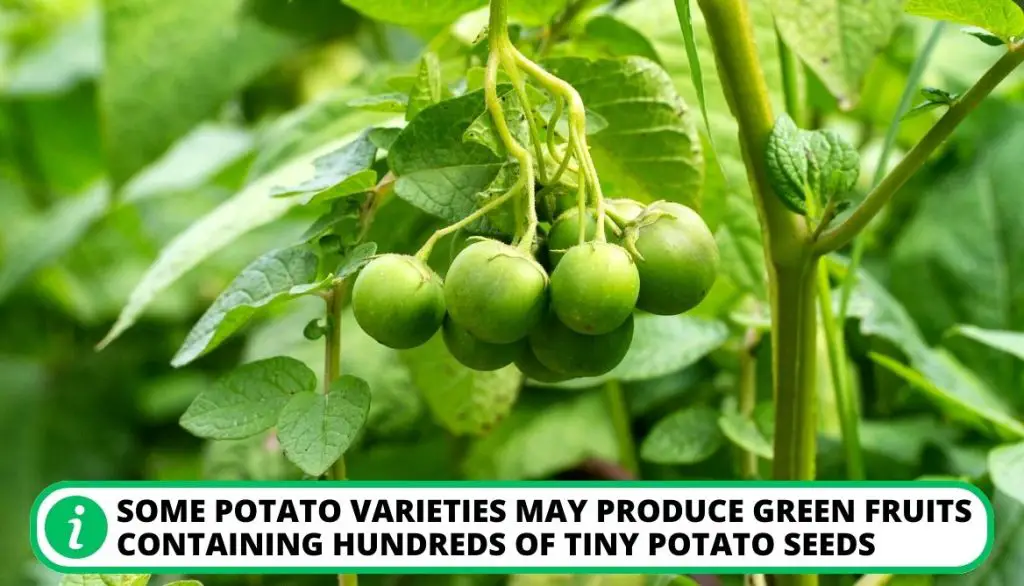
Eating potato berries are poisonous because they contain high concentrations of glycoalkaloids. This toxin can make you ill, and it is what gives a potato fruit its bitter and unpleasant taste.
What is the Purpose of Potato Fruit?
Potato fruits have no value to gardeners:
- These tiny fruit-like green cherry tomatoes should not be consumed because they contain poisonous glycoalkaloids.
- The fruits are also not ideal for planting because they rarely reproduce true-form seeds.
- Some horticulturists also believe that growing potato berries can negatively affect tubers’ harvest yield.
Should I Remove Potato Fruit?
Removing the berries is unnecessary unless you want to reproduce potatoes from their seeds.
- Most gardeners do not remove potato fruit.
- If you have small children or pets and wish to prevent them from accidentally ingesting potato berries, eliminating them is ideal.
- If there is no worry about unintentional ingestion, leaving the potato berries as they are is the best thing to do because removing them is not common practice.
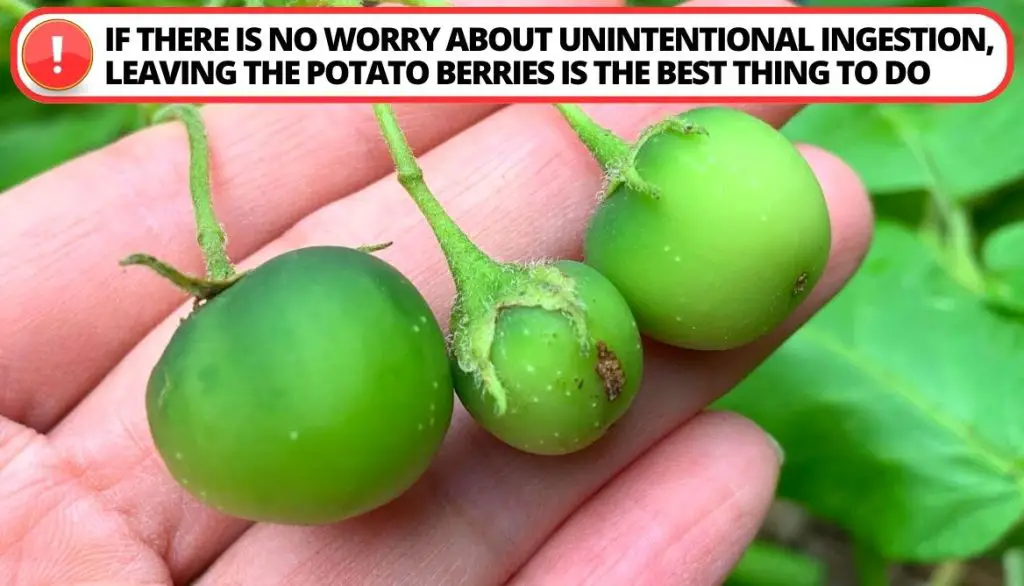
For small-scale farmers such as home gardeners, pruning a few potato berries is much more straightforward, given the small number of plants. However, if you are dealing with a large-scale plantation, pruning the potato fruit may increase production costs, and the cost of work involved may exceed the value of the yield difference.
5 Factors Which Affect the Formation of Potato Flowers and Potato Fruits
Noticing potato blossoms and berries on your plants can be a scary experience. However, some conditions may favor and vice versa reduce this green fruit production. Let’s know them:
1. Climate
Potatoes thrive mainly in a cool and humid climate. Given that their origin is from South America’s cool and temperate areas, such as the Andes Mountains range. Potato plants flower and produce berries when subjected to their native growing conditions.
That means if the temperatures are maintained below 80 degrees and with humidity, your potato plants will flower and produce fruit in plenty.
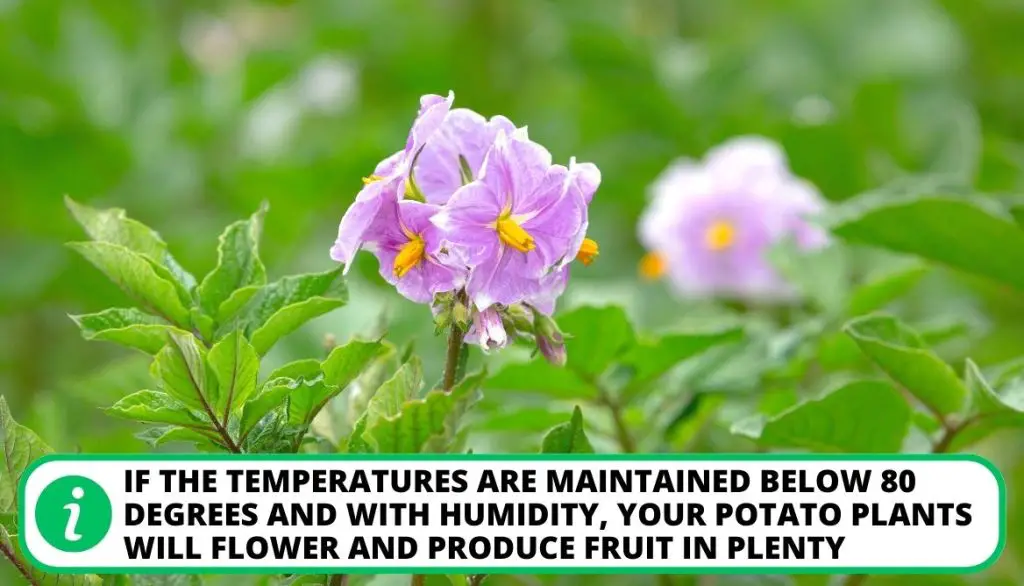
2. Disease
As they grow and thrive, potatoes may accrue a variety of diseases, especially viruses. These viruses reduce the overall plant yield but can also lower the ability of potato plants flower to grow and produce berries.
You will likely notice potato flowers and fruit production on fresh and certified seed potatoes compared to tubers saved over the years when planting potato crops. Certified seed potatoes tend to have a reduced disease burden, resulting in a higher flowering rate.
3. Genetics
Over the years, potato farmers have practiced selective breeding, resulting in non-flowering potato seed varieties. Their focus has been on domesticated potatoes that produce large tubers and heavy yields.
As a result, many modern potato varieties will rarely or never flower, even when provided with the most ideal growing conditions. Some potato varieties may have potato flowers but fail to produce fruits or berries.
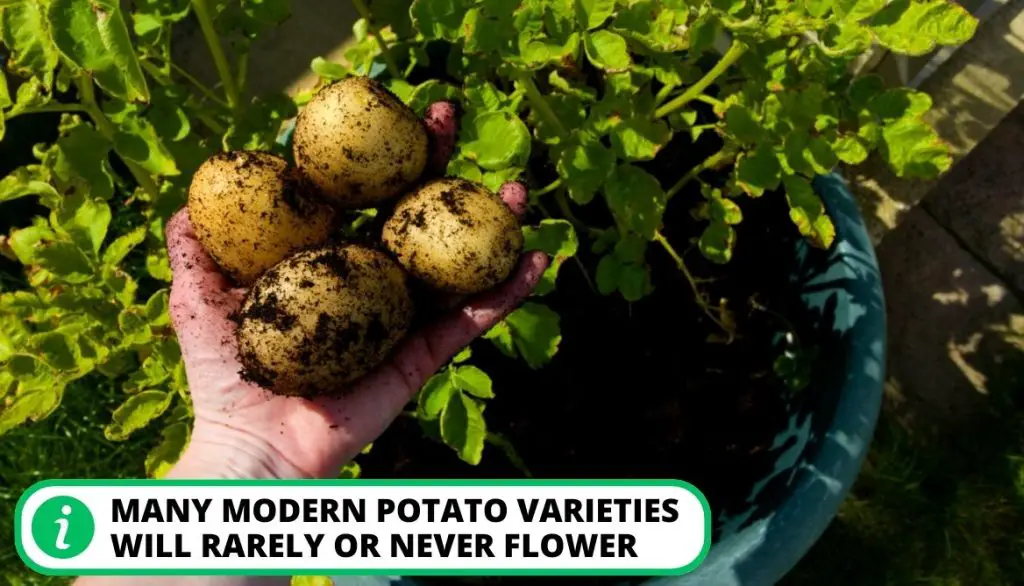
4. Pollination
The best potato flower pollinators are bumblebees because they vibrate their wings quickly, dislodging any pollen grains from the flower. However, others are poor pollinators, such as honey bees, because they are less effective than bumblebees.
Therefore, if you notice a lot of bumblebees on your potato flowers, you should expect potato plant flowers and berries.
5. Sterility
Modern potato varieties mainly have sterile pollen; therefore, they do not produce flowers or berries. However, if you grow multiple varieties of potato plants in one garden, cross-pollination will occur, creating more green cherry tomatoes.
How Toxic Are Potato Fruits?
Like all nightshade family plants, potatoes contain toxic compounds called glycoalkaloids. These toxins are found in different quantities in all parts of the plant. Flowers, fruit, and foliage produce large quantities of a glycoalkaloid called solanine, while tubers produce smaller amounts.
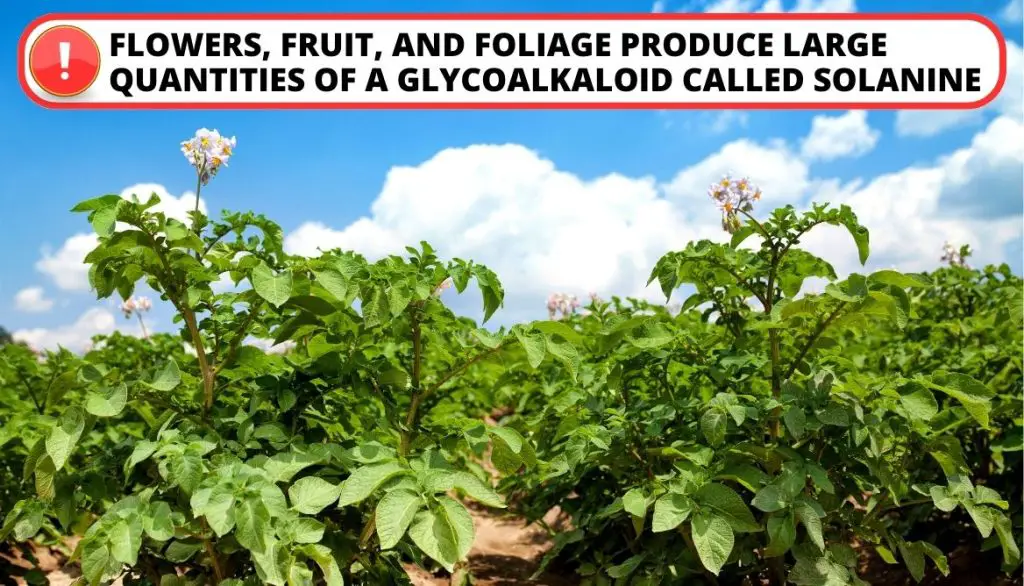
The berries of most commercial potato flower varieties have approximately ten times the quantity of glycoalkaloids as potato tubers. Although tubers also contain glycoalkaloids, they are considered safe for human consumption. The glycoalkaloids toxins occur as follows:
- Tubers have less than 200 milligrams per kilogram of tubers.
- Normal potato tubers contain 12 to 20mg per kg.
- Green potato tubers contain 250 to 280 mg per kg.
- Green-skinned tubers contain 1500 to 2200 mg per kg.
- Potato fruits contain about 177mg/kg to 1350mg/kg or more.
Symptoms of Solanine Poisoning
Solanine in potato berries is very toxic, even in smaller quantities. The level of toxicity and side effects largely depend on the concentration of glycoalkaloids in the specific berry and your body size.
Some people may experience toxicity symptoms at just 1mg/kg of body weight. That means an individual with a 130lbs body weight may not develop symptoms even after consuming 1 ½ to 10 ½ ounces of tomato flowers and fruits.
Because of their small body weight, children are more affected by solanine poisoning than adults.
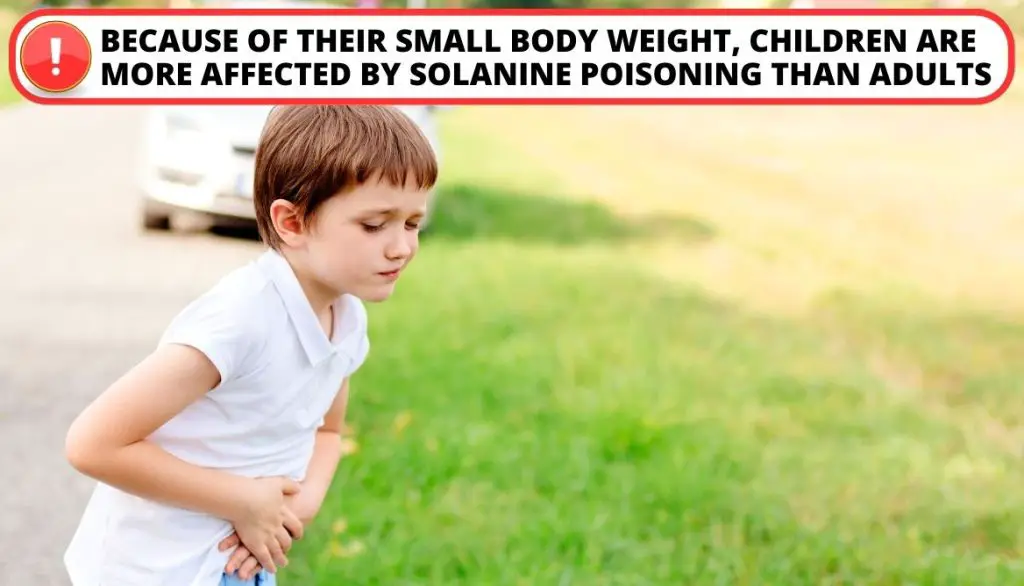
Solanine poisoning is primarily manifested in neurological and gastrointestinal disorders. Some of the symptoms include:
- Nausea and vomiting,
- Headache and dizziness,
- Diarrhea,
- Stomach cramps,
- Burning of the throat,
- Cardiac dysrhythmia,
- Nightmares and hallucinations,
- Loss of sensation or paralysis,
- Jaundice,
- Hypothermia,
- Death in very severe cases.
10 Environmental Factors Affecting the Yield of Potato Crops
Growing potatoes from certified seed tubers is easy and simple and provides food to eat all year round. However, to ensure optimum growth and a high yield, the right environmental conditions must be provided. Some factors that can affect potato yield include the following:
1. Mineral Nutrition
For optimal growth and development, potato plants need adequate supplies of both micro and macronutrients, including potassium (K), nitrogen (N), and phosphates (P). Low doses of nitrogen lower vigorous top growth and speed up the tuber formation process.
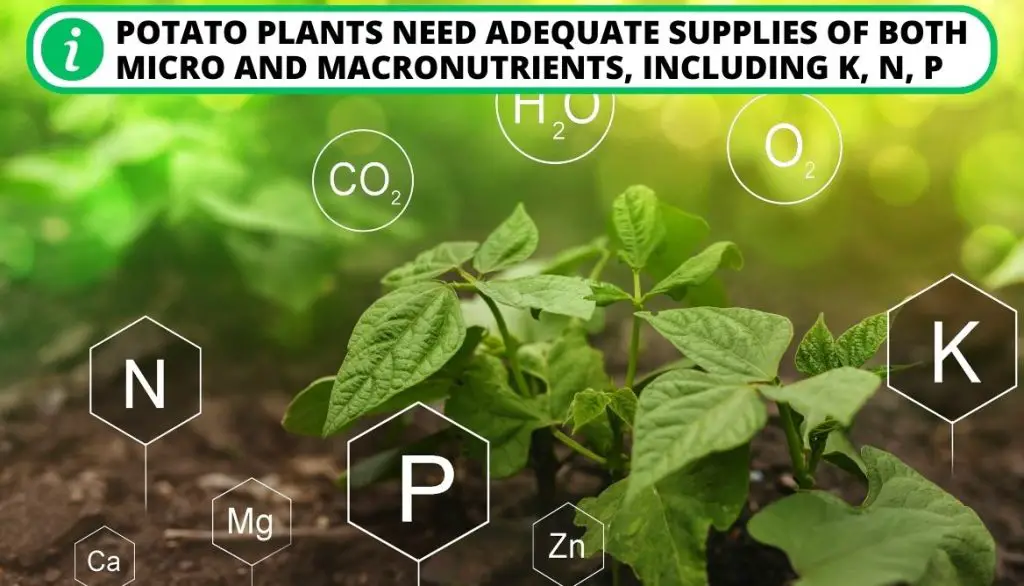
A fertilizer dose of 180 to 240kg of Nitrogen, 60 to 90kg of Phosphates, and 85 to 25,130 kg of potassium per acre is endorsed for alluvial soil. For black soils, you need 120 to 150 kg of Nitrogen and 50 kg each of potassium and phosphorus. For acidic soils, you require 120kg of Nitrogen, 115 kg of phosphorus, and 120 kg of potassium per hectare.
Keep in mind that the optimum fertilizer application dose will vary based on the following:
- Potato variety,
- Soil type,
- Crop rotation,
- Soil fertility,
- Climate,
- Moisture supply,
- Length of the growing season.
2. Light Quality and Intensity
Higher light quality and intensity will increase carbohydrate production, resulting in higher potato tuber yield. Potatoes require at least six hours of sunlight daily.
Compared to temperate climates, the light intensity in tropical climates must generate adequate potential photosynthetic energy. This is important for the production of sufficient crop yields throughout the tuber production process.
3. Temperature
The optimum day and night temperatures for the ideal potato growth and development are 25°C and 12°C. The most rapid growth takes place at 21°C. However, the growth rate increases with temperature increases and stops at 30°C.
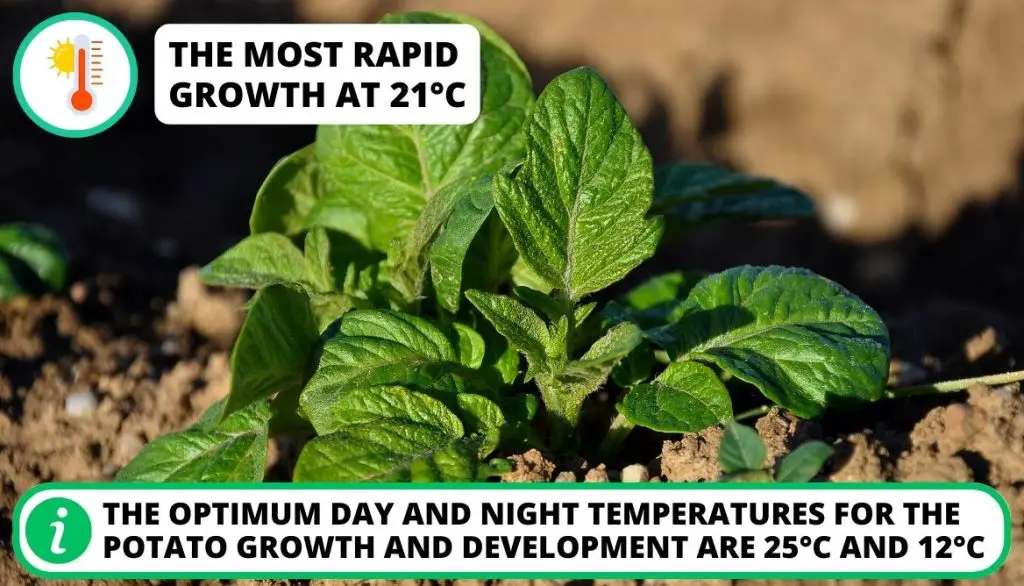
4. Water Regime
Water stress may hasten tuber formation resulting in a lower yield. Irrigation can help to increase tuber production and produce a higher yield of potatoes. Excessive irrigation or too much water caused by inundation prevents tuber formation by creating an anaerobic soil environment
5. Pathogens and Diseases
Potato plants are susceptible to different virus diseases like the purple top, rugose mosaic, and potato leaf roll. They may also be affected by fungal infections of the foliage, for example, early blight (Alternaria), Verticillium, and Fusarium wilts.
The tubers may also be affected by common scabs, Streptomyces, and blackleg bacterium resulting in tuber rots. You can avoid diseases affecting these plants by practicing a three to four-year crop rotation.
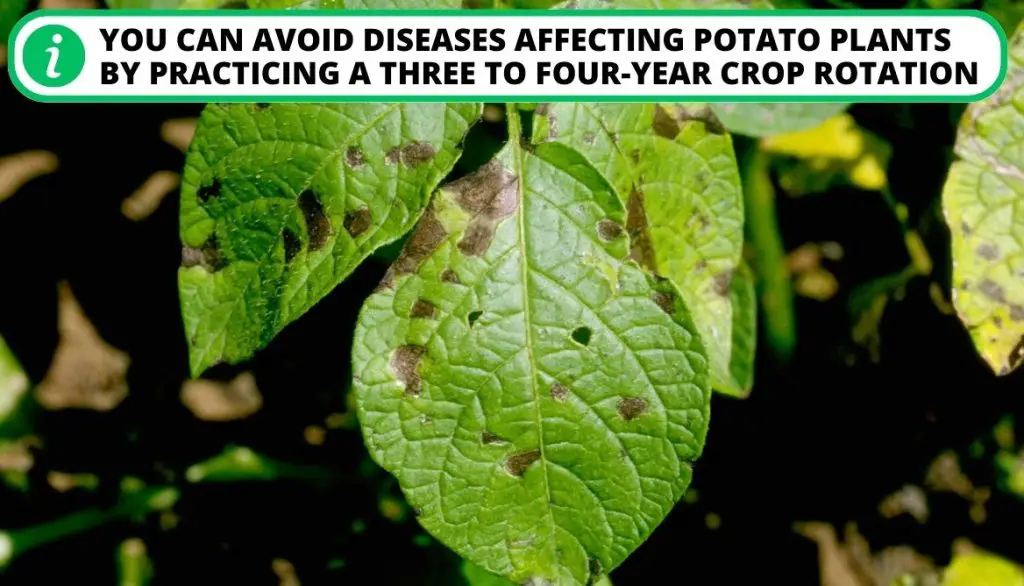
6. Cultivation
Potatoes usually develop more extensive root systems owing to proper cultivation. Friable and loose soil enhances the tuber set and the development of smooth, even-colored, and well-shaped potatoes. Cultivation can also help control weeds, acid penetration, soil aeration, and keeping the soil hilled.
7. Weed Control
Control of weeds is necessary as it results in a lower potato yield. Weeds compete with potato plants for nutrients, light, and water and are hosts for diseases and insects. When growing potatoes, weed control should include a system that uses herbicides, cultivation only, or a combination of both.
8. Insects
To increase yield when you grow potatoes, avoid planting them on fields that have been in grass or sod the previous years. This helps to decrease the chances of having white grub and wireworm problems.
However, if sod was in the soil the last year, use soil insecticide to prevent insects from damaging your tubers. This will protect your potatoes from leafhoppers, flea beetles, and cutworms.
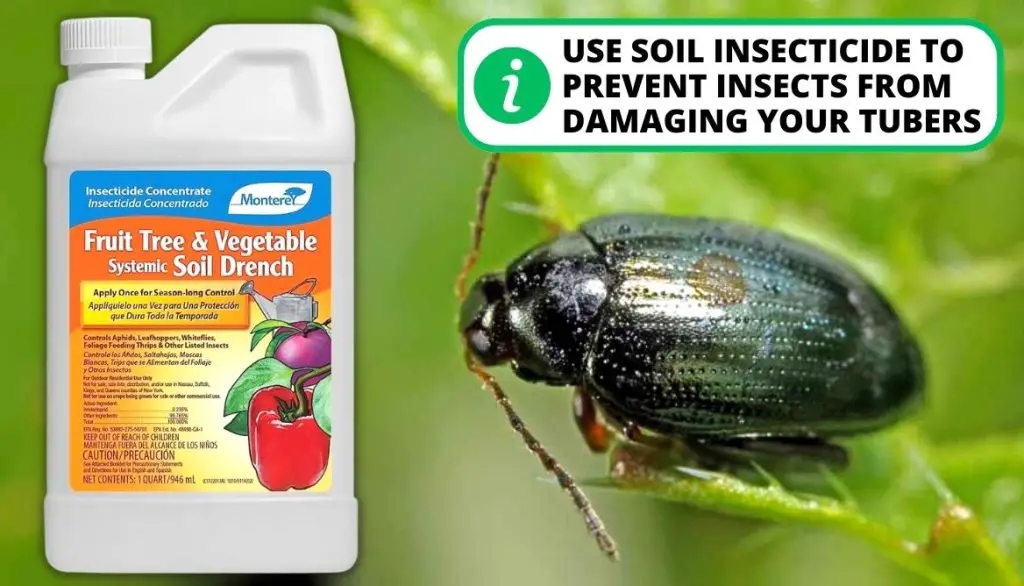
9. Potato Varieties
Always choose potato varieties best suited for your environmental and climatic conditions and market. You can always try new varieties of potatoes in your on-farm trials.
10. Soil pH
Potatoes thrive well in various soils, and the soil pH may be as low as 5.0. However, the best yield of seed potatoes occurs at pH levels 5.5 to 6.8 because the potatoes become less prone to scab. Dolomitic limestone can be used when pH levels are too low.
What Is The Main Purpose Of Potato Flower?
The presence of potato plant flowers means that your vines are mature enough and have adequate leaf area to begin tuber formation. Until they mature, potato plants must be watered regularly throughout the summer, with at least one to three inches of water weekly or as required.
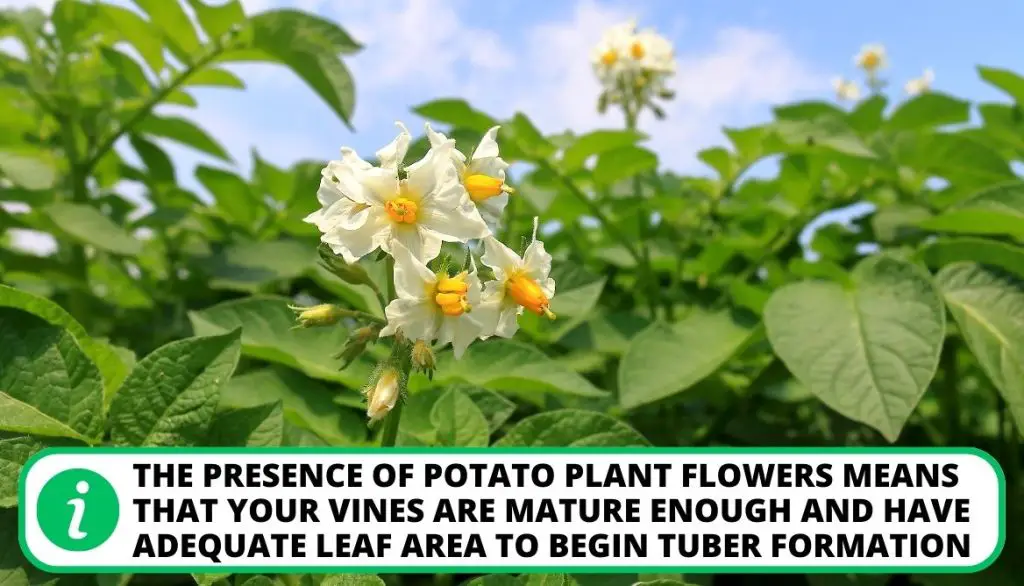
Is there a Benefit of Removing Potato Flowers?
As we know potato plants produce flowers, but there is no clear answer as to whether the yield will increase when they are removed. The truth is that pruning potato plant flowers will not reduce your tuber yield. However, potato flower removal will prevent the production of toxic potato berries that can cause health problems when ingested by humans or pets.
FAQ
Can You Eat the Fruit Off of a Potato Plant?
No, you cannot eat the fruit or berries of potato plants because they contain solanine, which is a poisonous alkaloid. The toxin in flowering potatoes makes the fruits unsuitable for human consumption and can cause severe gastrointestinal or neurological symptoms and even death in extreme cases.
Do We Eat Fruit or Stem of Potato?
No, the stem or fruit of potatoes is not eaten because of the presence of toxic glycoalkaloids. The tuber is a thickened part of the potato stem containing large amounts of edible starch. That makes the stem the only edible part of potato plants.
What Is A Potato Fruit Called?
Potato fruits have a variety of names, including potato apples, potato tomatoes, seed balls, or berries. Potato plants produce fruits that appear just like small, round cherry tomatoes. However, they are poisonous, making them unsafe for human consumption.
Is Any Potato Plant Part Poisonous?
Yes, all parts of the potato plant, including the leaves, potato flowers, and fruits, are poisonous, excluding the tuber. Potatoes contain a toxic substance known as solanine, which is found throughout the plant, especially in new sprouts and green potatoes.
Should I Remove Potato Leaves?
No, there is no need for you to prune healthy potato plants. Potatoes require plenty of leaves to help them produce sugars that can be stored as starch in their tubers. However, if your plants experience early leaf disease, pruning the leaves can help curb the problem by eliminating diseased leaves.
Conclusion
So the answer to your question ‘Should I remove potato fruit‘ is no, you shouldn’t. But if you are concerned about your pets and children can eat the berries, remove them. This is because potato fruits are poisonous because of the presence of solanine toxin. Therefore, humans or animals should not consume these berries.
On the other hand, if you grow potatoes on a large scale, removing these berries is never worth the resources and time involved. That’s why as you can see potato fruit removal depends solely on the circumstances.
Have you ever encountered potato plant flowers and fruits? What kind of potatoes was it? Please share with us in the comments.
- How to Get Potatoes to Sprout Eyes: Detailed Growing Guide with 3 Options - July 31, 2023
- Weight of a Medium Potato: Revealed in Detailed Guide - July 29, 2023
- Maris Piper Potatoes: 9 Substitutes You Should Know About - July 27, 2023
Hello! I’m Jessica Zander, a garden coach and consultant based in the Boston area (zone 6b), offering virtual consultations across the country and Canada.
I’ve been passionate about gardening since the early 1990s, and in 2022, I launched You Can Do It Gardening to empower individuals to feel more confident in their gardening endeavors.
Following a 30-year career in nonprofit finance and operations, I transitioned out of that field in mid-June of 2023 due to the growing demand for coaching services. Interestingly, my years of presenting financial statements to boards and finance committees proved to be valuable experience for teaching people about gardening! I enjoy sharing skills, providing guidance and suggestions, and collaborating efficiently with clients to make significant improvements to their outdoor spaces, both small and large. I also regularly teach at the Arlington Continuing Education and Cambridge Adult Education.
My approach is direct and practical, akin to Mary Poppins, but tailored to your garden. Clients find satisfaction in saving money and taking pride in their own gardening achievements.

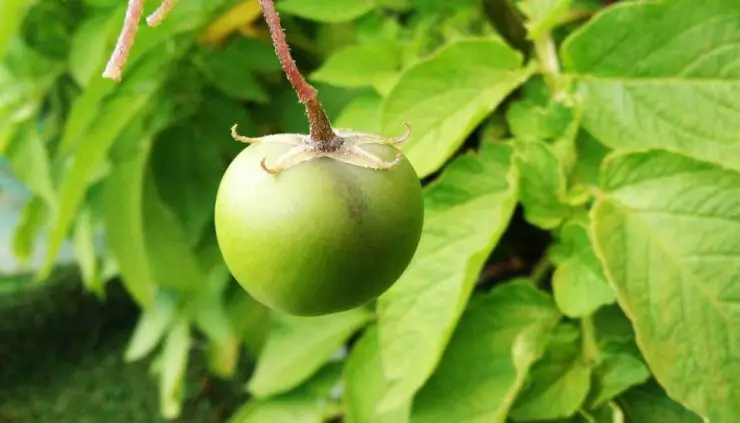
Add comment